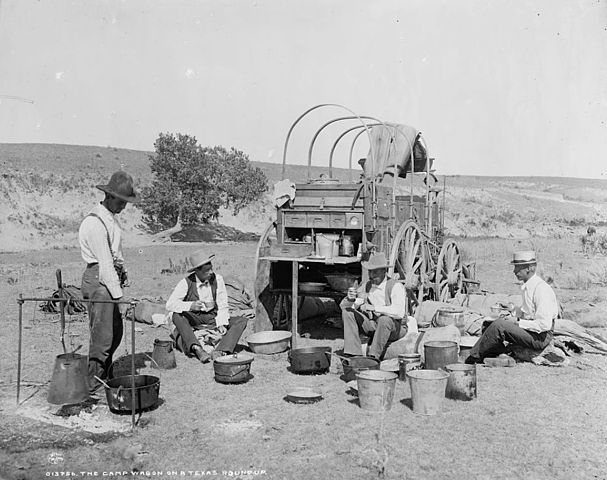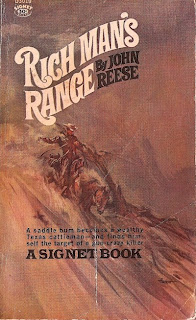This is an old story that is often retold in westerns. Like Odysseus of old, a man returns home after many years of wandering. There he finds his house in disorder, and heads
must roll before he can be reunited with the woman he once left behind. Reese
may or may not have had The Odyssey
in mind when he wrote this novel, but the parallels are many, and he’s given
them a sly twist or two.
Plot. After an eight-year absence, George Merrit
finds his way back to Strickland, Texas, where he has inherited half a
40,000-acre ranch. The other half has been willed to the widow of the previous
owner. A high-strung woman, Bonnie Keller has never forgotten her humble
origins as the daughter of “movers,” whose gypsy habits once branded her as
white trash. Before marrying the now-dead rancher, she was also at one time
Merrit’s lover.
Like Penelope in
Homer’s epic poem, Bonnie has her suitors. One of them is the psychopathic
manager of a neighboring ranch, Aaron Davidson, who wants to get his hands on
her property. Seems her ranch is about to jump in value as a new railroad is
being built across it, and he needs money to pay off an embarrassing debt.
In Homer’s version,
Odysseus enlists the assistance of his now-grown son, Telemachus, to help
retake possession of his home. The hero in Reese’s novel discovers only after
his return that he has a son, a boy who unfortunately died in infancy. To take
on Davidson, Merrit gets help from another suitor instead, a lawyer named
Newton Price, who quotes Shakespeare and is rarely sober.
Also coming to his
aid are the ranch’s cowhands, three amigos from his years as a gold miner in Sonora, and several Mexicans,
who turn out to have an agenda of their own. On Merrit’s behalf, Price brings a
suit against Davidson for conspiracy to defraud. And for a while the story
turns into a bracing courtroom drama enlivened with charges made by the
battered madam of the local whorehouse.
 |
| Roundup camp, Texas, 1900 |
Style. I would call this an adult western, and not
just because of the whores and mention of venereal disease (referred to as
being “laid up”). The stormy relationship between Merrit and the widow is
fraught with recriminations, sarcasm, tears, and racy sexual undercurrents.
When the two have a scene together, the soapy dialogue gets pretty trashy as
injured pride reaches for all the clichéd accusations and rejoinders. Matters
may even get physical, and not in a nice way.
But when Reese is
not knee-deep in the battle of the sexes, the writing is sharp and original,
often salty. Here the narrator sums up Bonnie’s family background:
The riffraff
she was born into called themselves horse-traders, but anything they had that
was worth trading was stolen. Their men were deadbeats, thieves, so lazy they
stank.
The story moves
forward at a brisk pace. The first chapter is breathlessly packed with
character and incident as exposition is deftly woven into the narrative.
Throughout the novel, there are mysteries about the past that are revealed
without warning. You have to pay close attention or the details can slip by
you.
In a curious motif,
Merrit has been shot through his upper thigh, even before the novel’s opening,
and he is often pulling down his pants to inspect the slowly healing wound.
There are surprising social observations as when we’re told that cowhands have
“a lonely man’s bad judgment about women.” They’ll fall in love with a whore
and remain devoted to a lady boss, harboring fantasies of one day marrying her.
 |
| John Reese |
Wrapping up. This is an enjoyable western story, having fun
as it does with the standard conventions and pushing limits with the
temperature of its sexual politics. The intensity of Merrit’s confrontations
with the women in his life parallels the novel’s abrupt bursts of violence and
the brutality of the deaths he witnesses. In later novels, Reese would break up
the point of view so that a story is told through the eyes and ears of several
members of a community rather than a single protagonist at the center.
Rich Man’s Range is currently available at AbeBooks. For more of Friday’s Forgotten Books, click on
over to Patti Abbott’s blog.
Further reading:
BITS reviews of other
John Reese novels
Photo credits: Wikimedia Commons
Author's photo, goodreads
Author's photo, goodreads
Coming up: Horace Annesley Vachell, Bunch Grass (1912)

Don't think I've ever read anything by him. Not sure how I've missed his work.
ReplyDeleteI see John Reese as another example of the writers who had to adapt to the changing markets. In the 1940's he had his pulp career, then when they died he broke into the higher paying slick market, especially THE SATURDAY EVENING POST. But then by 1962 the slick fiction market was dying and he started writing original paperback fiction.
ReplyDeleteAnd as you point out, his fiction was usually of interest and enjoyable.
His photograph reflects his sense of humor with that smile on his face.
ReplyDelete